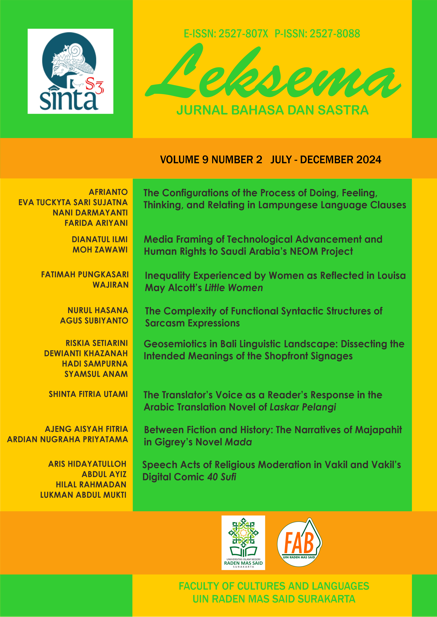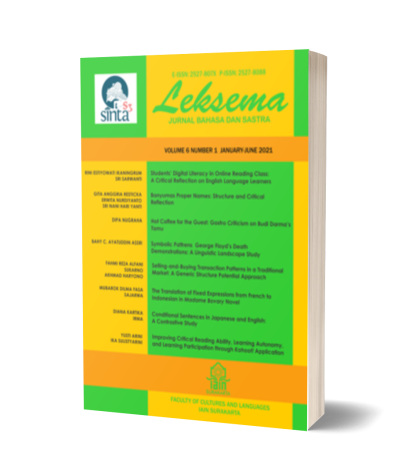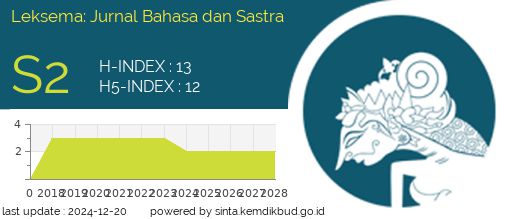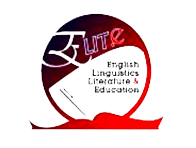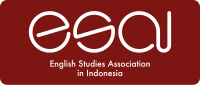BETWEEN FICTION AND HISTORY: THE NARRATIVES OF MAJAPAHIT IN GIGREY'S NOVEL 'MADA'
DOI:
https://doi.org/10.22515/ljbs.v9i2.9671Keywords:
historical construction, historical fiction, Mada, MajapahitAbstract
The Majapahit Empire has been a source of inspiration for writers of historical fiction, such as Gigrey with his novel Mada. Unfortunately, these historical fictions have the possibility to make readers experience misunderstanding in comprehending history. Therefore, this study aimed to reveal to what extent historical deviation can be considered as creativity and not deviation and whether it can be considered a deviation when the writer develops the history excessively. This study employed a descriptive-qualitative method and used Lindbald's theory of historical fiction for analyzing the data. The result shows that there is a historical narrative that can be categorized as creativity because it is so imaginative and does not trap readers in false history. Meanwhile, one form of creative change in the novel that traps can be seen when Nertaja is told as Tribhuwana Wijayatunggadewi's adopted son. Because of these creative changes, many readers are trapped in a false history as evidenced by the comments on Goodreads. This is exacerbated by promotional narratives about the author's extensive research, making common reader even more trapped in the falsehood.
Downloads
References
Carroll, Richard. 2011. “The Trouble with History and Fiction”. M/C Journal 14 (3). https://doi.org/10.5204/mcj.372.
Djono et al. 2012. “Nilai Kearifan Lokal Rumah Tradisional Jawa”. Humaniora 24 (3): 269-278. https://doi.org/10.22146/jh.1369.
Gigrey. 2024. Mada: A Historical Fiction Novel. Depok: PT Akad Media Cakrawala.
Goodreads. “Ratings & Reviews for MADA Gigrey”. https://www.goodreads.com/book/ show/58435762-mada#CommunityReviews.
id.akad and gisellarahman. 2023, October 16. Instagram. https://www.instagram.com/p/ CydY2hghRhn/?igsh=MWd6enU4YTVxaHhndg==.
Kertapradja, Ng. 2014. Serat Babad Tanah Jawi (Edisi Prosa Bahasa Jawa versi J.J. Meinsma, 1874). Yogyakarta: Penerbit Garudhawaca.
Lindbald, Jan Thomas. 2018. “History and Fiction: An Uneasy Marriage?”. Humaniora 30 (2): 147-157. https://doi.org/10.22146/jh.34619.
Litt, Toby. 2008. “Against Historical Fiction”. Language and Languages 5 (1): 111-115.
Mangkudimedja, RM. 1979. Serat Pararaton Ken Arok 2 (transliteration and translation by Drs. Hardjana HP). Jakarta: Departemen Pendidikan dan Kebudayaan - Proyek Penerbitan Buku Sastra Indonesia dan Daerah.
Merdeka.com. 2023, July 16. “Warga di Jombang Ini Mengaku Keturunan Majapahit, Bahasa Sehari-hari Bukan Bahasa Jawa”. https://www.merdeka.com/jatim/warga-di-jombang-ini-mengaku-keturunan-majapahit-bahasa-sehari-hari-bukan-bahasa-jawa-4896-mvk.html.
Midaada, Avirista. 2023, 8 March. “Mengenal Aria Bebed, Anak Mahapatih Gajah Mada yang Konon Berasal dari Bali”. Okezone https://nasional.okezone.com/read/2023/03/ 08/337/2777237/mengenal-aria-bebed-anak-mahapatih-gajah-mada-yang-konon-berasal-dari-bali.
Muljana, Slamet. 1953. Prapantja: Nagarakretagama. Jakarta: Penerbit Siliwangi.
Muljana, Slamet. 2006. Tafsir Sejarah Nagarakretagama. Yogyakarta: LKIS Yogyakarta.
Muljana, Slamet. 2007. Runtuhnya Kerajaan Hindu-Jawa dan Timbulnya Negara-Negara Islam di Nusantara (Cetakan ke-4). Yogyakarta: LKIS Yogyakarta.
Muljana, Slamet. 2021. Menuju Puncak Kemegahan (Sejarah Kerajaan Majapahit). Yogyakarta: LKIS Yogyakarta.
Munandar, Agus Aris. 2008. Ibukota Majapahit: Masa Jaya dan Pencapaian. Jakarta: Komunitas Bambu.
Munandar, Agus Aris. 2011. Catuspatha Arkeologi Majapahit. Jakarta: Wedatama Widya Sastra.
Nugroho, Irawan Djoko. 2011. Majapahit Peradaban Maritim Ketika Nusantara Menjadi Pengendali Pelabuhan Dunia. Jakarta: Yayasan Suluh Nuswantara Bakti.
Remmelink, Willem. 2022. Babad Tanah Jawi: The Chronicle of Java (The Revised Prose Version of CF Winter Sr.). Leiden: Leiden University Press.
Ricklefs, Merle Calvin. 2007. Sejarah Indonesia Modern 1200-2004. Jakarta: PT Serambi Ilmu Semesta.
Siwi Sang. 2016, 29 Juli. “Koreksi Siwi Sang atas Tafsir Prof I Ketut Riana Soal Silsilah Keluarga Maharaja Majapahit Sri Hayam Wuruk”. https://siwisang.wordpress.com/2016/07/29/ koreksi-siwi-sang-atas-tafsir-prof-i-ketut-riana-soal-silsilah-keluarga-maharaja-majapahit-sri-hayam-wuruk/.
Sudibyo. 2000. “Mistifikasi dan Pengagungan Kekuasaan dalam Babad dan Hikayat: Kontinuitasnya dalam Sistem Kekuasaan Indonesia Modern”. Humaniora 12 (2). https://doi.org/10.22146/jh.690.
Suji, I Ketut. 2021. “Ista Dewata dalam Siwa Tattwa”. Kementerian Agama Republik Indonesia: Hindu. https://kemenag.go.id/hindu/ista-dewata-dalam-siwa-tattwa-2mz6tf.
Tyas, Khusnul Khotimah Mustikaning. 2018. “Penggunaan Novel Sejarah sebagai Sumber Belajar Sejarah”. Jurnal Pendidikan Sejarah 7 (2): 85-103. https://doi.org/10.21009/JPS.072.05.
Ulum, Raudatul. 2017. “Hindu Bali Rasa Lombok: Mengembangkan Harmoni dengan Identitas Lokal”. In
I Nyoman Yoga Segara (ed.). Dimensi Tradisional dan Spiritual Agama Hindu. Jakarta: Puslitbang Bimas Agama dan Layanan Kegamaan, Badan Litbang dan Diklat, Kementerian Agama Republik Indonesia.
Undang-Undang Republik Indonesia Nomor 1 Tahun 1974 tentang Perkawinan. https://peraturan.bpk.go.id/Download/36382/UU%20Nomor%201%20Tahun%201974.pdf
Wirasutisna, Haksan. 1980. Kidung Sunda II. Jakarta: Departemen Pendidikan dan Kebudayaan, Proyek Penerbitan Buku Bacaan Sastra Indonesia dan Daerah.
Downloads
Published
Issue
Section
License
Copyright (c) 2024 Leksema: Jurnal Bahasa dan Sastra

This work is licensed under a Creative Commons Attribution-NonCommercial-ShareAlike 4.0 International License.
The copyright of the received article shall be assigned to the publisher of the journal. The intended copyright includes the right to publish the article in various forms (including reprints). The journal maintains the publishing rights to published articles.
In line with the license, the authors and users (readers or other researchers) are allowed to share and adapt the material only for non-commercial purposes. In addition, the material must be given appropriate credit, provided with a link to the license, and indicated if changes were made. If authors remix, transform or build upon the material, authors must distribute their contributions under the same license as the original.

